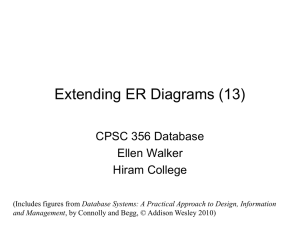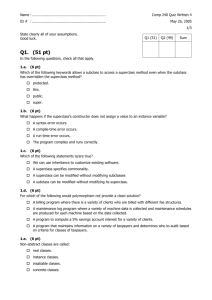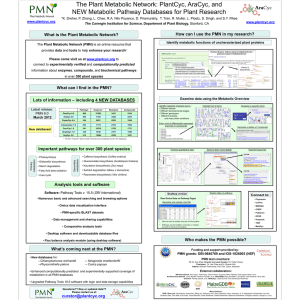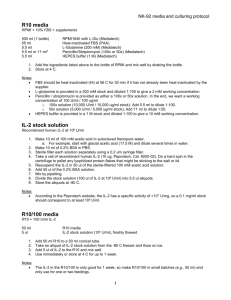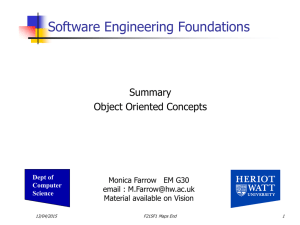bj3ch10_solutions
advertisement
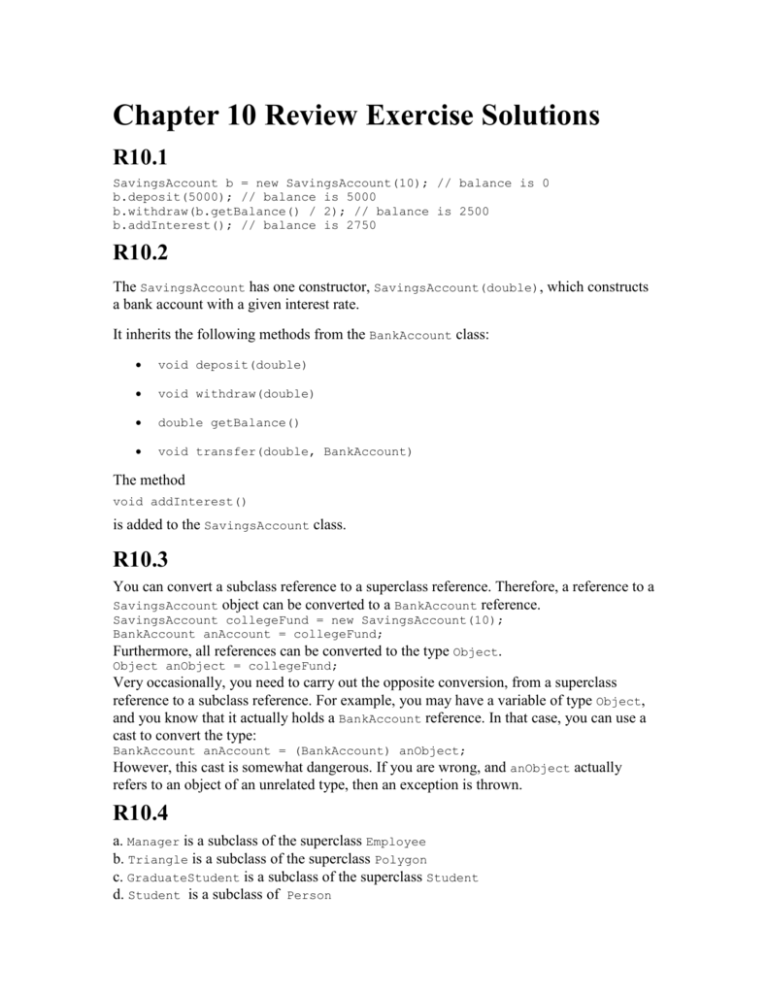
Chapter 10 Review Exercise Solutions R10.1 SavingsAccount b = new SavingsAccount(10); // balance is 0 b.deposit(5000); // balance is 5000 b.withdraw(b.getBalance() / 2); // balance is 2500 b.addInterest(); // balance is 2750 R10.2 The SavingsAccount has one constructor, SavingsAccount(double), which constructs a bank account with a given interest rate. It inherits the following methods from the BankAccount class: void deposit(double) void withdraw(double) double getBalance() void transfer(double, BankAccount) The method void addInterest() is added to the SavingsAccount class. R10.3 You can convert a subclass reference to a superclass reference. Therefore, a reference to a SavingsAccount object can be converted to a BankAccount reference. SavingsAccount collegeFund = new SavingsAccount(10); BankAccount anAccount = collegeFund; Furthermore, all references can be converted to the type Object. Object anObject = collegeFund; Very occasionally, you need to carry out the opposite conversion, from a superclass reference to a subclass reference. For example, you may have a variable of type Object, and you know that it actually holds a BankAccount reference. In that case, you can use a cast to convert the type: BankAccount anAccount = (BankAccount) anObject; However, this cast is somewhat dangerous. If you are wrong, and anObject actually refers to an object of an unrelated type, then an exception is thrown. R10.4 a. Manager is a subclass of the superclass Employee b. Triangle is a subclass of the superclass Polygon c. GraduateStudent is a subclass of the superclass Student d. Student is a subclass of Person e. no relation between Employee and GraduateStudent f. CheckingAccount is a subclass of the superclass BankAccount g. Car is a subclass of the superclass Vehicle h. Minivan is a subclass of the superclass Vehicle i. Minivan is a subclass of the superclass Car j. Truck is a subclass of the superclass Vehicle R10.5 Sandwich x = new Sandwich(); // legal Sub y = new Sub(); // legal; x = y; // legal y = x; // not legal y = new Sandwich(); // not legal x = new Sub(); // legal R10.6 R10.7 R10.8 Student is a Person Employee is a Person Professor is an Employee TeachingAssistant is an Employee Secretary is an Employee DepartmentChair is a Professor Janitor is an Employee SeminarSpeaker is a Person Seminar is a Course Lecture is a Course R10.9 r r r r r r instanceof instanceof instanceof instanceof instanceof instanceof Rectangle: true Point: false Rectangle2D.Double: false RectangularShape: true Object: true Shape: true R10.10 super has two meanings: 1. to invoke the superclass constructor, e.g. super(initialBalance); 2. to invoke a superclass method, e.g. super.deposit(amount); this has two meanings: 1. to invoke another constructor of the same class, e.g. this(0); 2. to denote the implicit argument of a method The first meanings of super and this are related, because they both are ways of invoking another constructor. R10.11 The first call this.g(); is an example of late binding. For example, if another class E extends D, and that class redefines the method g(). and f is called on an E object, then this.g() calls E.g. The second call super.g(); is an example of early binding. No matter what the actual type of this, the exact same method is always called (namely the closest definition of g in the inheritance chain.) R10.12 The endOfMonth calls are resolved by early binding because there is no implicit object– there are two static methods with the same name but different parameters, and the compiler merely picks the appropriate one. The call to getBalance is resolved by late binding because the selection of which account's balance is displayed does not take place until the program runs. R10.13 A shallow copy only copies numbers and object references to an object. A deep copy makes copies of all objects on which an object depends. R10.14 We recommend that all fields (both instance and static fields) have private access. However, constants (static final fields) can have public access. R10.15 Methods should generally be public or private. We recommend avoiding the use of package-visible methods. Public methods are the norm, and private methods should be for used implementation-dependent tasks that should be carried out only by methods of the same class. Static methods should have public access because they do not operate on an implicit parameter, so it is very likely that they will be called from an object that does not belong to the same class. R10.16 The System.in and System.out static fields are final, so you cannot assign new values to them. You can change them with the setIn and setOut methods. (You may wonder how the setIn and setOut methods are implemented–how can these methods change a final field? They call native methods setIn0 and setOut0 that are able to circumvent this language restriction.) R10.17 Public fields are dangerous because any instruction in a (potentially large) program can change their value. Public static fields are, if anything, even more dangerous because not even an object reference is required to change the value. R10.18 A label is a display area for a short text string or an image, or both. The text cannot be edited. A text field holds a single line of editable text. A text area displays multiple lines of editable text. R10.19 The append method is defined in the JTextArea class. The setText method is defined in the JTextComponent class. The getGraphics method is defined in the JComponent class.

